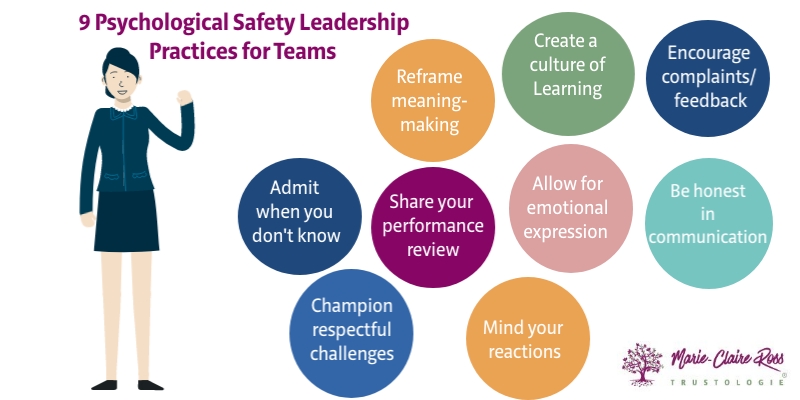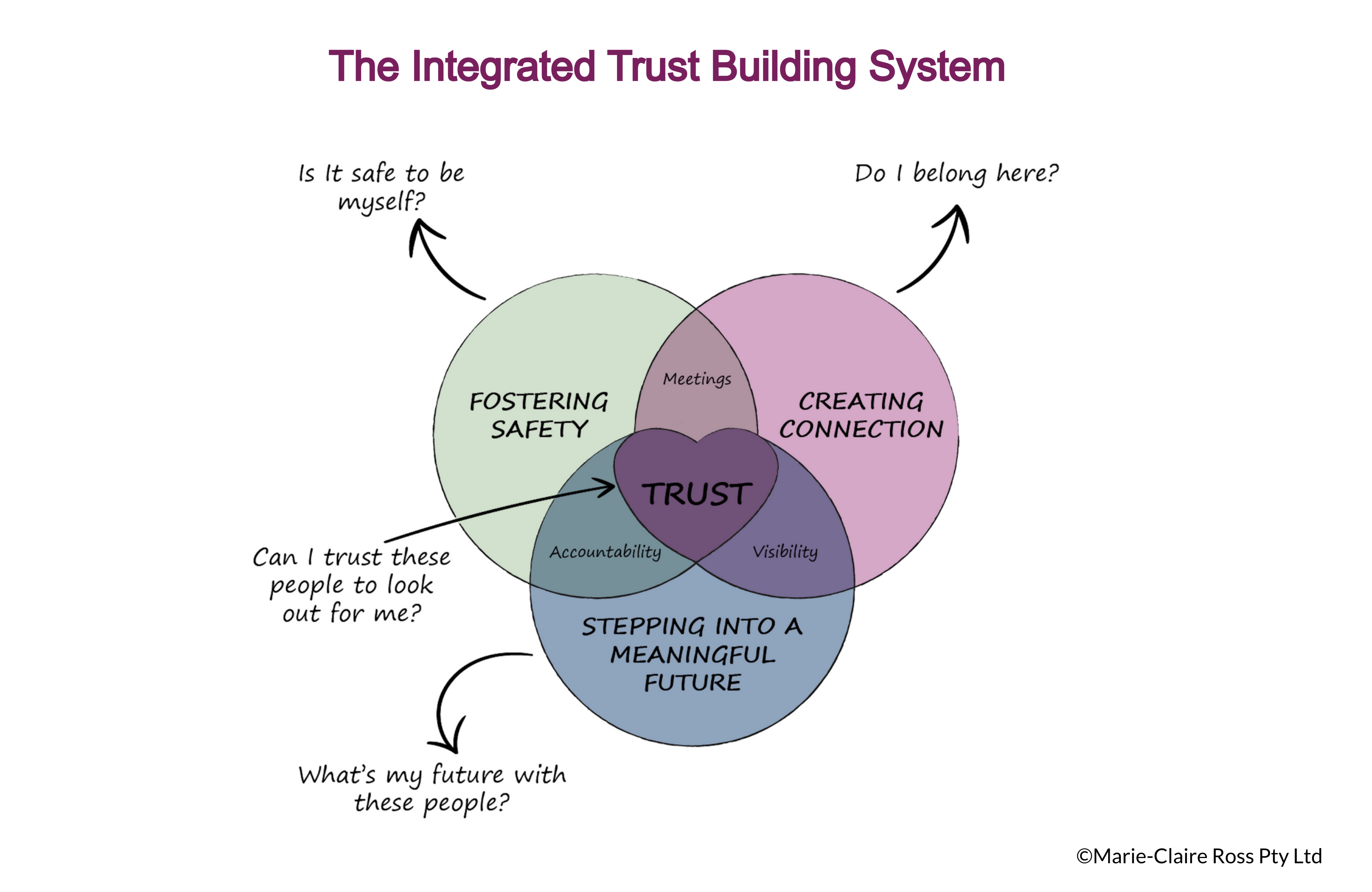
“Organisations learn only through individuals who learn.” Peter Senge, MIT
Unfortunately, 86% of employees feel as though people at their workplace are not heard fairly or equally and only one in three employees feel like they can freely express their views and suggestions with their manager.
In a fear-based culture, leaders don't know really know what's going on. Fear drives things underground. Your team members and peers will be holding back from expressing their views, suggestions and flagging potential issues because the environment seems too risky.
High performers want to be able to speak up and they want leaders who can help them do that.
Of course, we can't make people feel 100% safe. The management of emotions is a personal responsibility that lies with each individual. It is up to all of us to recognise and address the fears we carry, especially when they hinder our ability to have genuine and transparent conversations with others. Feeling safe and improving our sense of psychological safety is in the hands of each person.
With that said, here are some steps leaders can work on to foster a safe team environment:

Humans are meaning-making machines. Despite our best intentions we don't respond to actual situations and events. Instead, we respond to our interpretation of the event or the story we tell about ourselves about what happened.
The meaning we make about situations at work is based on stories we tell about it. Depending upon people's personality and life experience that can be empowering or disempowering.
In an uncertain world, we have little control over our circumstances. However, we can control the meaning we place on the situation.
Employees who feel unsafe, particularly during change, often need help to choose more positive stories to describe their experiences.
In team meetings, if people express how they wasted time, had a negative customer experience or made lots of mistakes, help them see how that is helping their learning. Reframing a negative experience will ensure they feel safe and supported in the team. Which then connects to the next point....
Learning and psychological safety are inextricably linked. Psychological safety creates an environment where people are willing to learn and supports a growth mindset. We are more likely to adapt to change in a culture where learning from mistakes is rewarded and indeed, celebrated.
On the other hand, we can't learn if we don't feel we are in a safe work environment. Psychological safety enables people to go outside of their comfort zone and learn new things. It also encourages people to engage in learning behaviours such as sharing information, asking for help or experimenting. Learning supports people in reaching their full potential and feeling that the organisation cares about them.
Otherwise, people are more likely to fall into “learning anxiety” where they become defensive if things don't go as well as they expected.
This is detrimental to transforming an organisation because mistakes are seen as embarrassing rather than an opportunity to learn and improve. People are more concerned about protecting their own self-interests than finding solutions. They put limits on what's possible and their own capabilities.
With your team, create a culture of learning by hosting regular learning opportunities for growth where you learn together. Share errors and what to do to fix them. Also encourage more strategic learning opportunities for the team. This could be encouraging team members to share conference learnings, insights they have gleaned from books or articles or even sharing footy coaching or volunteering learnings outside of work hours.
Yet, the real benefit of psychological safety is that it enables candour. Allowing people to openly express issues, so that you don't get derailed by unforeseen issues.
Have an open door policy where employees can come and tell you about negative experiences and roadblocks. This includes encouraging employees to challenge you or question how things are done.
There will always people complaining and seeing things that you don't. At the same time, you don't know everything and they have a different perspective to what's going on in the team or workplace. They may be right or wrong - but the fact that they are willing to let you know is a positive and means they trust you. Often, they are so close to the problem, they can sometimes struggle to work out how to fix it. And that's where you can come in.
Engage in open-ended questions to uncover the essence of their concern. Remain receptive to the possibility that they may be sharing valuable insights, shedding light on an issue that requires attention or an opportunity that should be seized. If you suspect that their venting is a result of needing support, respond with compassion to create a safe space for them to express themselves and feel psychologically secure.
Make sure you don't bite, act defensive or non-committal. Request additional ideas or information. If required, actively seek out different perspectives to get a more holistic view of the issue.
Be clear about not tolerating feedback that is rude about other people, too general or fear-based. Make it clear that feedback must be based on good intentions. It's not an invitation to be rude under the false pretence of being “honest.” Thank people for letting you know things that are uncomfortable.
Keep people updated on the progress of their concern, so that you demonstrate that you are taking their issues seriously. If you decide not to act on their concern, also let them know why.
This will encourage team members to feel comfortable interacting with each others in the team at this level, knowing that they have the support and trust of the leader.
Safe environments reduce the negative impact of interpersonal risk-taking.
What stops a lot of people from sharing how they feel is that they are worried that people will negatively react to their emotions. Fear of judgment, fear of criticism and fear of retribution stops people from expressing their true feelings.
When we feel different to others in our team, we fear that how we feel about things will upset people. For a lot of people, they bottle up their frustration with outdated processes, concern that no-one likes them or feeling overwhelmed with their workload.
Allow for emotional expression. Encourage employees who work from home to use emojis to express how they feel. Schedule emotional check-ins in meetings to normalise emotions, so that people know it's okay to share. After all, we are more likely to understand others through shared feelings than shared thoughts.
If other people in your team, negate another person's feelings, kindly let them know that it's not appropriate.
Leaders are often told to create psychological safety in teams and ask for feedback on their leadership - both good and bad.
However, a study "Taking your Team Behind the Curtain: The Effects of Leader Feedback-Sharing and Feedback-Sharing" by C. Coutifaris and A. Grant found that is not always helpful.
Across three field studies, the researchers found that sharing critical managerial feedback from the leader's performance spurred greater effects.
What they found was that when leaders initially shared negative feedback about themselves from their own performance reviews, they were awkward about it. Employees were skeptical. However, as leaders continued to share (and being publicly accountable to improving), they were more comfortable and employees responded in kind. Creating a virtuous cycle whereby vulnerability was the norm and safety started to increase.
Yet, when leaders requested feedback from their staff they often were defensive about what they received (which was often quite broad and not helpful). This didn't improve safety in team long-term. In my opinion, this was probably more to do with the general nature of the feedback.
The morale of the story is that if you want to improve psychological safety in your team, share your performance review and ask for specific advice from your team members. The more specific you can be in what you are trying to improve with you own leadership will encourage your own team members to offer you advice and look within themselves to improve their own behaviours.
One of the astonishing features of an achievement zone team is that team members support one another to do their best work. They aren't afraid to challenge one another to improve their performance. The team culture encourages risks without fear and honest communication.
Yet, in many teams that I work with, challenging one another is often rated at around the 35% mark in teams. People are so afraid to talk to their peers about improving their results.
Conflict is normal and even encouraged in high-performing teams. In a low-performing team, people don't voice their opinion. If they do, it tends to be in a passive-aggressive manner that only reduces trust.
To avoid this, a great leader encourages team members to not only challenge each other but the leader themselves. Let everyone know that they are free to challenge ideas at all levels and that they are expected to come from a respectful solution-focused perspective. A perspective that is based on helping the customer or the company.
Monitor challenge exchanges in teams. Reward positive challenges and pull up negative challenges that are provocations. Encourage team members to avoid jumping to conclusions about what the person is saying and not judging or blaming.
It is a common human fear that we have done something wrong and people are going to tell us off.
Make it safe for your direct reports by acknowledging when you don't know something and ask for help.
Confess when you've messed up. In a positive manner, admit you have done something wrong. You don't have to get all theatrical and make it a big song and dance. Instead, normalise your mistake, preferring to laugh about it, rather than exclaim "I'm so stupid."
In this day and age where an inclusive culture is needed for successful teams, work on challenging your own bias and encourage others to be mindful of their pre-conceived notions.
Developing self-awareness is critical here and asking others for specific feedback on your blind spots. Particularly, when it comes to issues outside of your experience such as being neurodiverse, young or mature in today's world, LGBTQI+ or from a different culture or religion. This helps other feel more included, so they don't feel unsafe expressing their view.
Furthermore, admit when there is uncertainty and that you don't know how you and the team will solve tricky issues, but let people know you are certain that as a team you'll work it out together using everyone's know-how and voices.
Openly share information (except for confidential matters). Regularly communicate, where the business stands, why work matters, what's coming up next, and how you plan to get everyone there. Share the decision-making process and help people see how company decisions have considered them.
As I mention in my book, Trusted to Thrive (get a free chapter here), people are observing our body language. How we interact and react matters.
You emotionally signal to people that we're all in this together through asking questions in meetings and one-on-ones, through improving visibility of work, being approachable and demanding and modelling reciprocal accountability.
Micro-interactions matter - congratulating others, recognising effort, supporting those going through a tough time and providing eye contact in meetings. It means reflecting on how you react when an employee makes a mistake, so they can confidently make mistakes without fear.
When those interactions are negative - they create micro-stressors that build up. The more micro-stressors that accumulate in our day, the more stressed we feel. Avoid sending evening or weekend emails. Make sure your interactions lift people, not make them question themselves or your ability to trust them.
What leaders say and do makes up to a 70% difference as to whether an individual reports feeling included and safe. In a workplace, we need to feel psychologically safe before we can trust a colleague or leader to do the right thing by us.
As Amy Edmondson says, ‘Trust is about giving others the benefit of the doubt, while psychological safety relates to whether others will give you the benefit of the doubt when you've made a mistake or ask for help.'
Employees want their leaders to back them up and make fair decisions on their behalf. They want to express their own identity and not be afraid to be themselves. After all, we all want to feel seen, valued and heard. Leaders who focus on a supportive environment, where a psychologically safe team environment is a priority, not only improve employee well-being, but team dynamics and future performance.
And isn't that what we all want?
If you want to be part of a group of leaders learning how to be better people managers, then check out my Leadership Mastermind. There are a few spaces left.
In fear-based cultures, people withhold information, avoid speaking up, and hide problems. Leaders often do not know what is really happening because issues are pushed underground, increasing risk and reducing performance.

“Organisations learn only through individuals who learn.” Peter Senge, MIT

Trust is often easy to build within teams.